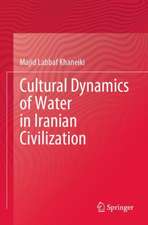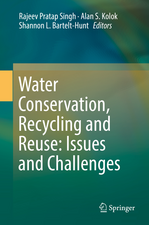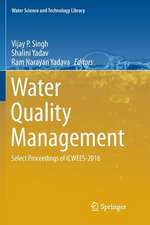Qanat Knowledge: Construction and Maintenance
Autor Ali Asghar Semsar Yazdi, Majid Labbaf Khaneikien Limba Engleză Hardback – 15 dec 2016
Where does one begin to dig to ensure that the qanat tunnel will flow with water? How are practical considerations of landscape factored into the design? How are water quality and discharge measured? How does excavation proceed through bedrock and unconsolidated soil and how is this knowledge of geology and pedology acquired? How are vertical wells and tunnels excavated to maintain proper air supply, light, and water flow? How does one deal with special problemslike tunnel collapse, the accumulation of gasses and vapors, and the pooling of water during construction? How are tools and gauges designed, maintained, and used? How have qanats been incorporated into other structures like watermills, reservoirs, ice houses, and irrigation networks? And how are qanats cleaned, extended, maintained through the ages, and incorporated into modern water supplies?
The great contribution of this work is the story it tells of the ingenuity and practical skills of the qanat masters who for centuries and generations have cut an uncountable number of tunnels through bedrock and alluvium using hand tools and homespun solutions to problems that would vex the most experienced university-trained engineers.
| Toate formatele și edițiile | Preț | Express |
|---|---|---|
| Paperback (1) | 550.99 lei 38-44 zile | |
| SPRINGER NETHERLANDS – 15 iul 2018 | 550.99 lei 38-44 zile | |
| Hardback (1) | 645.79 lei 3-5 săpt. | |
| SPRINGER NETHERLANDS – 15 dec 2016 | 645.79 lei 3-5 săpt. |
Preț: 645.79 lei
Preț vechi: 759.76 lei
-15% Nou
Puncte Express: 969
Preț estimativ în valută:
123.58€ • 129.61$ • 102.87£
123.58€ • 129.61$ • 102.87£
Carte disponibilă
Livrare economică 11-25 martie
Preluare comenzi: 021 569.72.76
Specificații
ISBN-13: 9789402409550
ISBN-10: 9402409556
Pagini: 130
Ilustrații: XVIII, 179 p. 124 illus., 13 illus. in color.
Dimensiuni: 155 x 235 x 15 mm
Greutate: 0.57 kg
Ediția:1st ed. 2017
Editura: SPRINGER NETHERLANDS
Colecția Springer
Locul publicării:Dordrecht, Netherlands
ISBN-10: 9402409556
Pagini: 130
Ilustrații: XVIII, 179 p. 124 illus., 13 illus. in color.
Dimensiuni: 155 x 235 x 15 mm
Greutate: 0.57 kg
Ediția:1st ed. 2017
Editura: SPRINGER NETHERLANDS
Colecția Springer
Locul publicării:Dordrecht, Netherlands
Cuprins
Chapter 1. Introduction.- Chapter 2. Hydrology mechanism of qanat.- Chapter 3. Locatingqanat.- Chapter 4. Digging of shaft wells and qanat gallery.- Chapter 5. Barriers and limitations of qanat construction and rehabilitation.- Chapter 6. Tools and Equipments.- Chapter 7. Qanat maintenance and preservation.- Chapter 8. Qanat related Structures.
Textul de pe ultima copertă
This book offers a ready solution for those who wish to learn more about this fascinating part of our water history and makes accessible to the wider world the traditional knowledge gained from building and maintaining qanats for more than 2,500 years. There is much more here than a summary of the nature and distribution of qanats, and a more extensive journey through the philosophy, methods, tools, and terminology of qanat design and digging than previously assembled.
Where does one begin to dig to ensure that the qanat tunnel will flow with water? How are practical considerations of landscape factored into the design? How are water quality and discharge measured? How does excavation proceed through bedrock and unconsolidated soil and how is this knowledge of geology and pedology acquired? How are vertical wells and tunnels excavated to maintain proper air supply, light, and water flow? How does one deal with special problemslike tunnel collapse, the accumulation of gasses and vapors, and the pooling of water during construction? How are tools and gauges designed, maintained, and used? How have qanats been incorporated into other structures like watermills, reservoirs, ice houses, and irrigation networks? And how are qanats cleaned, extended, maintained through the ages, and incorporated into modern water supplies?
The great contribution of this work is the story it tells of the ingenuity and practical skills of the qanat masters who for centuries and generations have cut an uncountable number of tunnels through bedrock and alluvium using hand tools and homespun solutions to problems that would vex the most experienced university-trained engineers.
Where does one begin to dig to ensure that the qanat tunnel will flow with water? How are practical considerations of landscape factored into the design? How are water quality and discharge measured? How does excavation proceed through bedrock and unconsolidated soil and how is this knowledge of geology and pedology acquired? How are vertical wells and tunnels excavated to maintain proper air supply, light, and water flow? How does one deal with special problemslike tunnel collapse, the accumulation of gasses and vapors, and the pooling of water during construction? How are tools and gauges designed, maintained, and used? How have qanats been incorporated into other structures like watermills, reservoirs, ice houses, and irrigation networks? And how are qanats cleaned, extended, maintained through the ages, and incorporated into modern water supplies?
The great contribution of this work is the story it tells of the ingenuity and practical skills of the qanat masters who for centuries and generations have cut an uncountable number of tunnels through bedrock and alluvium using hand tools and homespun solutions to problems that would vex the most experienced university-trained engineers.
Caracteristici
Comprehensive book on the traditional engineering, construction and maintenance of qanats Explores the geographical diffusion of qanats across the world and its role in forming and nourishing human civilizations in arid and semi-arid zones Sheds light on hydrology mechanisms and applications to fields like generating energy, sanitation, and irrigation networks Includes traditional methods to maintain and preserve qanats and destructive factors such as earthquakes and human induced threats

















